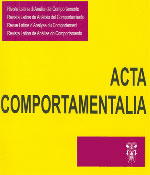Señalización no diferencial de distintas probabilidades de entrega de agua en dos subciclos de un programa definido temporalmente
Contenido principal del artículo
Resumen
Detalles del artículo
Cómo citar
Ribes- Iñesta, E., Torres, C., & Mayoral, A. (2010). Señalización no diferencial de distintas probabilidades de entrega de agua en dos subciclos de un programa definido temporalmente. Acta Comportamentalia: Revista Latina De Análisis Del Comportamiento, 8(1). Recuperado a partir de https://journals.unam.mx/index.php/acom/article/view/14646
Citas en Dimensions Service

<a rel="license" href="http://creativecommons.org/licenses/by-nc-sa/4.0/"><img alt="Licencia de Creative Commons" style="border-width:0" src="https://i.creativecommons.org/l/by-nc-sa/4.0/88x31.png" /></a><br />Este obra está bajo una <a rel="license" href="http://creativecommons.org/licenses/by-nc-sa/4.0/">licencia de Creative Commons Reconocimiento-NoComercial-CompartirIgual 4.0 Internacional</a>.
